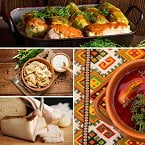One fascinating fact is how seasonality and local produce shape the Ukrainian diet. Centuries ago, people ate only what was available in their region, and that created a rich tapestry of regional dishes—like banosh from the Carpathians (a creamy cornmeal porridge with bryndza cheese and pork) or kulish, a hearty Cossack millet porridge cooked over fire. These dishes are not only comforting but carry deep historical roots.
Ukrainians also have a strong tradition of using fermentation—cabbage, cucumbers, apples, beets, and even tomatoes are pickled in brine for winter. It’s a culinary technique that started for survival and turned into an art. Even today, a Ukrainian grandmother’s pantry is often a rainbow of glass jars filled with homemade preserves and pickles.
Let’s not forget ritual foods, like kutia (a sweet wheat dish with poppy seeds, honey, and nuts), which is eaten on Christmas Eve. Every spoonful is symbolic—kutia represents unity, memory of ancestors, and the sweetness of life.
And here's a fun fact: Ukrainians love salo, or cured pork fat. While many people around the world avoid fatty cuts, in Ukraine salo is eaten with black bread, garlic, onions, and even dipped in chocolate at festivals! It’s a source of pride and humor—there are even jokes and songs written about it.
Ukrainian cuisine is more than just food—it’s an emotional, cultural, and historical experience. Every dish tells a story. So, the next time you enjoy a bowl of borscht or taste homemade varenyky, remember that you’re not just eating—you’re connecting to centuries of resilience, tradition, and flavor.
Quick Search

Prices & Services
Letters from 2$
Fast Gift Delivery
2-way Video Chat
5 Membership Levels
View all rates
